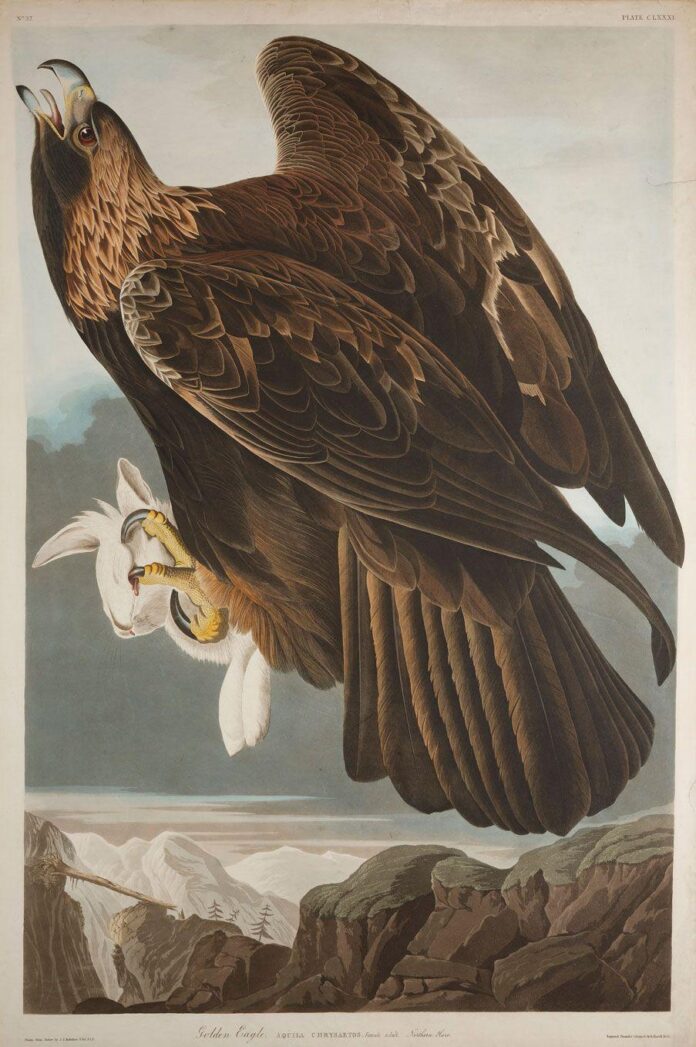Compton Verney hosts an exhibition this summer of John James Audubon’s Birds of America (1827-38), on tour from National Museums Scotland. Close to 12 years in the making, the book’s 435 hand-coloured prints offer a comprehensive index of American ornithology, reflecting Audubon’s ambitious project to document every one of the country’s bird species. With its epic, nation-spanning scope, Birds of America anticipates the democratic catalogues of Walt Whitman’s Leaves of Grass, published in 1855. “Here is not merely a nation but a teeming Nation of nations,” wrote Whitman in his preface; one wonders if he had America’s diverse nation of birds in mind.
The exhibition draws from the National Museums Scotland library collection, which has one of only 120 complete copies of the series in existence. Almost never displayed, the prints have undergone extensive conservation treatment, offering visitors a fleeting opportunity to view them in their massive, multi-coloured splendour. Displayed alongside letters, photographs and manuscripts telling the story of the artworks and the controversial man behind them, Birds of America prompts valuable questions about the role of art in natural history, the legacy of colonialism and the ongoing realities of environmental breakdown.

Purple grackles is one of the 435 hand-coloured prints in Birds of America © National Museums Scotland
Close to a metre high (printed on so-called double elephant sheets), Audubon’s life-size illustrations are undeniably dynamic, portraying each species in a stylised natural environment. Beautifully intricate, they established a standard of natural history illustration that is still highly regarded, setting the stage for later ornithologists including Edward Lear and Henry Constantine Richter.
There is an undercurrent of violence in Audubon’s work. His huge, muscular birds of prey claw at the flesh of rabbits, fish and frogs, frequently drawing blood, reflecting the brutality of the artist’s practice as a huntsman. Audubon would study species in the wild before collecting his own specimens, later manipulating them into elaborate, wire-strung poses. As such, his birds often appear in unnatural positions, both twisted and hunched, revealing an inherent tension between scientific naturalism and dramatic, even Romantic, grandeur.

One of Audobon’s prints depicting the now extinct Carolina parakeets © National Museums Scotland
While the accuracy of his illustrations and the vast number of birds he killed has been contested, Audubon’s contribution to the study of natural history remains influential. He identified more than 20 new birds during his fieldwork. Two centuries later, his series documents a number of species—from the passenger pigeon to the Carolina parakeet—that have since become extinct. The exhibition closes with a film examining the plight of currently endangered avian species.
Nevertheless, Audubon’s reputation as a white nationalist slave owner with an active interest in phrenology has rightly generated new waves of
controversy. “His charge sheet is substantial,” wrote the Spectator’s Claudia Massie of the show in Scotland, “and, frankly, it’s a miracle this exhibition even exists.”
“We feel that it is important to engage with difficult historical realities, rather than pretend that they didn’t happen,” says the curator Oliver McCall, “and are conscious of the need to do this in a meaningful and sensitive way.” Compton Verney has worked closely with National Museums Scotland and Elizabeth Lawal of the More Than a Moment group to enhance the exhibition’s contextual information, aiming, McCall continues, “to disentangle Audubon the historical figure from the mythologised creator of Birds of America.”

A winter hawk, as depicted by John James Audubon in his book Birds of America © National Museums Scotland
Most strikingly, the gallery has decided to drop Audubon’s name from the exhibition’s title, following a decision by the Seattle chapter of the National Audubon Society in 2022. “We were conscious to recognise the ethical complexities surrounding Audubon,” notes McCall. “These we can’t change.” But removing Audubon’s name helps draw the exhibition’s focus to “the work itself, which is a truly unique creation and a landmark in the field of ornithology and the history of naturalism”.
• Birds of America, Compton Verney, Warwickshire, 1 July-1 October

























